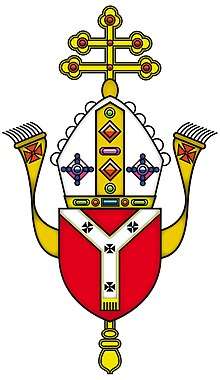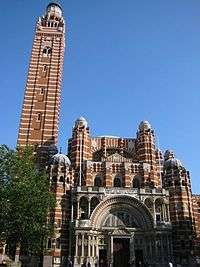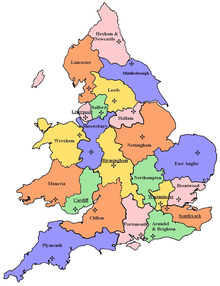Roman Catholic Diocese of Westminster
The Roman Catholic Diocese of Westminster is an archdiocese[1] of the Latin Church of the Catholic Church in England. The diocese consists of all of London north of the River Thames and west of the River Lea, the borough of Spelthorne (in Surrey), and the county of Hertfordshire, which lies immediately to London's north.
Diocese of Westminster Dioecesis Vestmonasteriensis | |
|---|---|
 Coat of Arms of the diocese | |
| Location | |
| Country | England |
| Territory | Greater London boroughs north of the Thames and west of Waltham Forest and Newham, plus the City of London, the districts of Staines and Sunbury-on-Thames, and the county of Hertfordshire. |
| Ecclesiastical province | Westminster |
| Deaneries | 23 |
| Statistics | |
| Area | 3,634 km2 (1,403 sq mi) |
| Population - Total - Catholics | (as of 2017) 4,914,400 439,740 (8.9%) |
| Parishes | 214 |
| Information | |
| Denomination | Catholic |
| Sui iuris church | Latin Church |
| Rite | Roman Rite |
| Established | 29 September 1850 |
| Cathedral | Westminster Cathedral |
| Secular priests | 366 |
| Current leadership | |
| Pope | Francis |
| Archbishop | Vincent Nichols |
| Auxiliary Bishops | |
| Vicar General | Martin Hayes |
| Website | |
| rcdow.org.uk | |
The diocese is led by the Archbishop of Westminster, who serves as pastor of the mother church, Westminster Cathedral, as well as the metropolitan bishop of the ecclesiastical Province of Westminster. Since the re-establishment of the English Catholic dioceses in 1850, each Archbishop of Westminster—including the incumbent, Cardinal Vincent Gerard Nichols—has been created a cardinal by the Pope in consistory, often as the only cardinal in England, and is now the 43rd of English cardinals since the 12th century. It is also customary for the Archbishop of Westminster to be elected President of the Catholic Bishops' Conference of England and Wales providing a degree of a formal direction for the other English bishops and archbishops. Though not formally a primate, he has special privileges conferred by the Papal Bull Si qua est.[2] The Archbishop of Westminster has not been granted the title of Primate of England and Wales, which is sometimes applied to him, but his position has been described as that of "chief metropolitan" of the Roman Catholic Church in England and Wales and as "similar to" that of the Archbishop of Canterbury in the Church of England (as the metropolitan bishop of the Diocese of Canterbury).[3] The diocese is one of the smallest dioceses in England and Wales in geographical area, but the largest in terms of Catholic population and priests.[4]
The suffragan sees of Westminster are the dioceses of Brentwood, East Anglia, Northampton, and Nottingham.
History
The diocese essentially covers the same region as the Church of England Diocese of London as it was before the English Reformation until 1850, adopting—like all other dioceses across England (created that year)[5]—an alternative name (originally because of the Ecclesiastical Titles Act 1851) but based on the centuries-old divisions of the country.[6] The diocese effectively survived the period of Catholic oppression in English history as a missionary territory established by canons accepted by Rome in 1622 as the Apostolic Vicariate of England which was in public law pronounced in England and Wales illegal as counter to the established church.
The mostly clandestine apostolic vicariate covering the country was divided so that the Apostolic Vicariate of London District formed on 30 January 1688 coinciding with a degree of freedoms. By decree of Pope Pius IX (Universalis Ecclesiae), this entity gained its elevation to the rank of a metropolitan diocese (instead of archdiocese) on 29 September 1850.
Present
On 3 April 2009, it was announced that the Archbishop of Birmingham, the Most Reverend Vincent Nichols, would become the 11th Archbishop of Westminster.[7] Cormac Murphy-O'Connor, who was installed as tenth Archbishop of Westminster on 22 March 2000 and was elevated to the rank of cardinal-priest of the title of Santa Maria Sopra Minerva by Pope John Paul II on 21 February 2001, became archbishop emeritus. Cardinal Murphy-O'Connor had announced on 9 July 2007 that, in accordance with the age limit of 75 years prescribed for bishops in the Code of Canon Law, he had submitted his resignation to Pope Benedict XVI, but that the Pope had asked him to continue in his pastoral ministry as archbishop beyond the age limit until further provision was made, as occurred in 2009.
The archbishop is usually assisted by four auxiliary bishops, each with specific areas of responsibility within the administration of the diocese. One of the auxiliary bishops serves as chancellor and moderator of the metropolitan curia; one as vicar for the clergy; one for pastoral affairs; and one for education and formation.
The metropolitan curia and chancery offices are located at Vaughan House, outside Westminster Cathedral in central London. The diocesan seminary, Allen Hall, is located in Chelsea, West London, and (with Ushaw College) is a direct descendant of the seminary of Douai College, France.
Bishops
Ordinaries
Vicars Apostolic of England (and Wales)
- William Bishop (1623-1624)
- Richard Smith (1624-1632)
- John Leyburn (1685-1688); see below
Vicars Apostolic of London District
- John Leyburn (1688-1702); see above
- Bonaventure Giffard (1703-1734)
- Benjamin Petre, O.S.B. (1734-1758)
- Richard Challoner (1758-1781)
- James Robert Talbot (1781-1790)
- John Douglass (1790-1812)
- William Poynter (1812-1827)
- James Yorke Bramston (1827-1836)
- Thomas Griffiths (1836-1847)
- Thomas Walsh (1848-1849)
- Nicholas Wiseman (1849-1850): see below; future Cardinal
Archbishops
- Cardinal Nicholas Wiseman (1850-1865): see above
- Cardinal Henry Manning (1865-1892)
- Cardinal Herbert Vaughan (1892-1903)
- Cardinal Francis Bourne (1903-1935)
- Cardinal Arthur Hinsley (1935-1943)
- Cardinal Bernard Griffin (1943-1956)
- Cardinal William Godfrey (1956-1963)
- Cardinal John Carmel Heenan (1963-1976)
- Cardinal Basil Hume (1976-1999)
- Cardinal Cormac Murphy-O'Connor (2000-2009)
- Cardinal Vincent Nichols (2009-present)
Coadjutor Vicars Apostolic
- James Yorke Bramston (1823-1827(
- Richard Challoner (1739-1758)
- Robert Gradwell (1828-1833), did not succeed to see
- Thomas Griffiths (1833-1836)
- Henry Howard (1720), did not take effect
- Benjamin Petre (1721-1734)
- William Poynter (1803-1812)
- James Robert Talbot (1759-1781)
Coadjutor Archbishops
- George Errington (1855-1860), did not succeed to see
- Edward Myers (1951-1956), did not succeed to see
Auxiliary Bishops
Living first, followed by deceased
- John Stanley Kenneth Arnold (2005-2014), appointed Bishop of Salford
- John Patrick Crowley (1986-1992), appointed Bishop of Middlesbrough
- Alan Stephen Hopes (2003-2013), appointed Bishop of East Anglia
- Nicholas Gilbert Erskine Hudson (2014-)
- Bernard Longley (2003-2009), appointed Archbishop of Birmingham
- Paul McAleenan (2015-)
- Vincent Gerard Nichols (1991-2000), appointed Archbishop of Birmingham; later returned here as Archbishop; future Cardinal
- Patrick O'Donoghue (1993-2001), appointed Bishop of Lancaster
- Arthur Roche (2001-2002), appointed Coadjutor Bishop of Leeds
- John Francis Sherrington (2011-)
- George Stack (2001-2011), appointed Archbishop of Cardiff, Wales
- John Wilson (2015-2019), appointed Archbishop of Southwark
- Emmanuel John Bidwell (1917-1930)
- Robert Brindle (1899-1901), appointed Bishop of Nottingham
- Basil Edward Christopher Butler (1966-1986)
- Joseph Butt (1911-1938)
- Patrick Joseph Casey (1965-1969), appointed Bishop of Brentwood
- David John Cashman (1958-1965), appointed Bishop of Arundel and Brighton
- George Laurence Craven (1947-1967)
- Patrick Fenton (1904-1918)
- Victor Guazzelli (1970-1996)
- Philip James Benedict Harvey (1977-1990)
- William Anthony Johnson (1906-1909)
- David Every Konstant (1977-1985), appointed Bishop of Leeds
- Gerald Thomas Mahon (1970-1992)
- David James Mathew (1938-1946), appointed apostolic delegate and titular archbishop
- Edward Myers (1932-1951), appointed Coadjutor here
- James Joseph O'Brien (1977-2005)
- James Laird Patterson (1880-1902)
- Algernon Charles Stanley (1903-1928)
- William Weathers (1872-1895)
Other priests of this diocese who became bishops
- Peter Emmanuel Amigo, appointed Bishop of Southwark in 1904
- Charles Michael Baggs, appointed Vicar Apostolic of Western District in 1844
- Charles Berington, appointed Coadjutor Vicar Apostolic of Midland District in 1786
- John Baptist Butt, appointed auxiliary bishop of Southwark in 1884
- Thomas Dunn, appointed Bishop of Nottingham in 1916
- Bonaventure Giffard, appointed Vicar Apostolic of Western District in 1688; later returned here as Vicar Apostolic
- Thomas Grant, appointed Bishop of Southwark in 1851
- John Larkin, appointed Coadjutor Bishop of Kingston, Ontario, Canada in 1832 and Bishop of Toronto, Ontario, Canada in 1849; neither took effect; became a Jesuit in 1840
- Henry O'Callaghan, appointed Bishop of Hexham and New Castle in 1887
- Mark O'Toole, appointed Bishop of Plymouth in 2013
- Francis Petre, appointed Coadjutor Vicar Apostolic of Northern District in 1750
- James Donald Scanlan, appointed Coadjutor Bishop of Dunkeld, Scotland in 1946
- James Smith, appointed Vicar Apostolic of Northern District in 1688
- John Talbot Stonor, appointed Vicar Apostolic of Northern District in 1715
- Thomas Joseph Talbot, appointed Coadjutor Vicar Apostolic of Midland District in 1766
- John Vertue (Virtue), appointed Bishop of Portsmouth in 1882
- William Walton, appointed Coadjutor Vicar Apostolic of Northern District in 1770
- Bernard Nicholas Ward, appointed Apostolic Administrator, later Bishop, of Brentwood in 1917
- William Gordon Wheeler, appointed Coadjutor Bishop of Middlesbrough in 1964, later Bishop, of Leeds in 1966
- Derek John Harford Worlock, appointed Bishop of Portsmouth in 1965
Liturgical and pastoral life

Liturgy in the diocese is primarily based around the ordinary form of the Roman Rite, promulgated by Pope Paul VI, now in its third edition. However, as might be expected from a city as cosmopolitan as London, there is a great diversity in the liturgy as celebrated by Catholics. The Latin Mass Society celebrates the liturgy according to the extraordinary form of the Roman Rite. The Ukrainian Greek Catholics have a strong presence in the diocese with their own cathedral in Binney Street close to Bond Street. There is a Lebanese Maronite community based at Our Lady of Sorrows Catholic Church in Cirencester Street in West London; a Melkite community in Pimlico, at St Barnabas' Church of England church; an Ethiopian Catholic church, Our Lady Queen of Heaven, in Queensway West London; an Eritrean Catholic church, St Aidan of Lindisfarne, in East Acton; a Chaldean Catholic church, St Anne's, in Laxton Place; and a Belarusian Catholic church in Holden Avenue in North London. There are also a large number of Masses for the expatriate Polish community; as well as French, German, Italian, Portuguese and Spanish language churches.
The diocese is also responsible for many chaplaincies, including Heathrow Airport, hospitals and prisons. See St. George's Interdenominational Chapel, Heathrow Airport for more information about the Heathrow Airport Latin-Church Catholic chaplaincy.
There are a large number of religious communities in the diocese. Religious orders of men include: the Assumptionists at Bethnal Green, Hitchin and Burnt Oak; the Augustinians at Hammersmith and Hoxton; the Augustinian Recollects at Kensal New Town, Kensington and Wembley; the Benedictines at Ealing Abbey and Cockfosters; the Carmelites at Finchley East; Discalced Carmelites at Kensington; the Christian Brothers at Twickenham; the missionary Columban Fathers at Hampstead; the Dominicans at Haverstock Hill; the Franciscans at Pimlico; the Franciscan Friars of the Atonement in Westminster; the Holy Ghost Fathers at New Barnett and Northwood; and the Passionists at Highgate. The Jesuits have a large presence in London with communities in Mayfair (at Farm Street), Kensington, Kilburn, Osterley, Southall, Stamford Hill, Swiss Cottage, Willesden Green, and Wimbledon. The Oratorians are based at the Church of the Immaculate Heart of Mary in Kensington, which is popularly known as the Brompton Oratory and is the largest church in the diocese after Westminster Cathedral.
Religious communities of women include the Carmelites at Golders Green and Ware; the Poor Clares in Barnet; the Franciscan Sisters of Our Lady of Victories at the cathedral; the Ursulines of Jesus at Hoxton, Kingsland and Stamford Hill; the Dominicans at Bushey, Cricklewood, Ealing, Edgware, Harpenden, Harrow on the Hill, Haverstock Hill, Hemel Hempstead, Osterley, Stevenage and Pinner. The Institute of the BVM is located in Swiss Cottage, Acton, Osterley, Redbourn and St Albans. The Sisters of Mercy are located at the cathedral, Acton East, Bethnal Green, Bow, Clapton Park, Commercial Road, Cricklewood, Feltham, Hampton Hill, Hillingdon, Kensal, Newtown, Marylebone Road, St Albans, St John's Wood, Twickenham and Underwood Road. The Servants of the Mother of God at Bayswater, Hampton and Somers Town.
The diocese is involved in both the independent and state school sectors. Some 159 state and 10 independent primary schools are run by the diocese along with 42 state and 4 independent secondary schools. There are also a further five independent primary / secondary and special schools including the Choristers school attached to the cathedral.
Music in the diocese is as diverse as the communities represented in it, but the all-male cathedral choir is reputedly one of the best in the country [8][9] and sings at all chief Masses in the cathedral as well as the daily divine offices. There are several choirs that specialise in Gregorian Chant and a Charismatic group centred on the diocesan seminary at Allen Hall.
See also
Notes and references
- Notes
- References
- "Our Diocese ..." Diocese of Westminster official website. Diocese of Westminster. Retrieved 14 June 2017.
- Herbermann, Charles, ed. (1913). . Catholic Encyclopedia. New York: Robert Appleton Company.
- "As ordinary of the Diocese of Westminster his jurisdiction extends over much the same area as that of the Bishop of London. As chief metropolitan, he occupies a position similar to that of the Archbishop of Canterbury, Primate of All England" (Herbermann, Charles, ed. (1913). . Catholic Encyclopedia. New York: Robert Appleton Company.). (At the bottom of the article, the first source listed is "Archives of the Diocese of Westminster.) Retrieved 2017-06-14. "By the grant in the Apostolic Constitution of 'certain new distinctions of preeminence', for the preservation of unity in government and policy, to the archbishop of Westminster for the time being, comprised under the following three heads: He will be permanent chairman of the meetings of the Bishops of all England and Wales, and for this reason it will be for him to summon these meetings and to preside over them, according to the rules in force in Italy and elsewhere. (2) He will take rank above the other two Archbishops, and will throughout all England and Wales enjoy the privilege of wearing the Pallium, of occupying the throne, and of having the cross borne before him. (3) Lastly, in all dealings with the Supreme Civil Authority, he will in his person represent the entire Episcopate of England and Wales. Always, however, he is to take the opinion of all the Bishops, and to be guided by the votes of the major part of them'. Thus, though the Archbishop of Westminster was vested with more powers and privileges than primates usually enjoy, unity of action has been safeguarded" (Herbermann, Charles, ed. (1913). . Catholic Encyclopedia. New York: Robert Appleton Company.).
- "Our Diocese..." Diocese of Westminster.
- The Anglican Diocese of Liverpool was not created until 1880, thirty years after the Roman Catholic Diocese (now Archdiocese) of Liverpool was established.
- Brady, William Maziere (1877). Annals of the Catholic hierarchy in England and Scotland, A.D. 1585-1876. London: John Mozley Stark.
- Damian Thompson (2 April 2009). "Archbishop Vincent Nichols is the new leader of Catholics in England and Wales, sources confirm". The Telegraph. telegraph.co.uk.
- Lindsay Koob (4 June 2010). "The world's finest academic choir takes its audience to choral heaven". Charleston City Paper. charlestoncitypaper.com. Retrieved 14 December 2010.
- Tom Hall (12 May 2003). "Palestrina: Westminster Cathedral Choir". The Journal (Newcastle, England). thefreelibrary.com Reviews.
External links
- Roman Catholic Diocese of Westminster official website
- GCatholic.org
- "Diocese of Westminster". Catholic-Hierarchy.org. David M. Cheney. Retrieved 21 May 2011.
- Parishes of the Diocese
